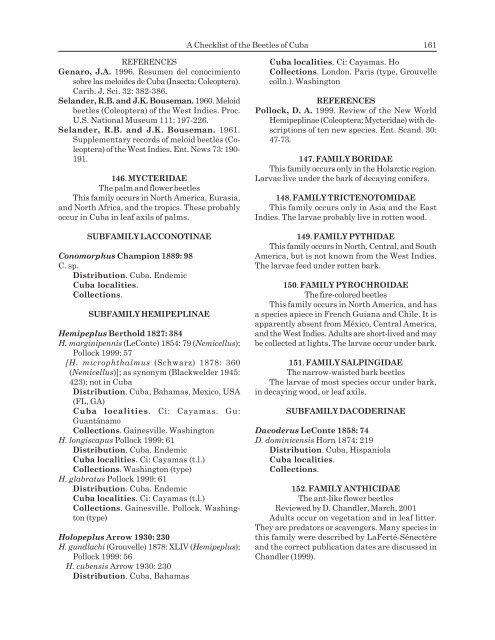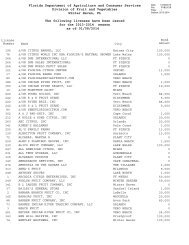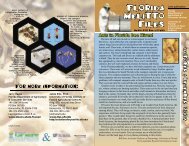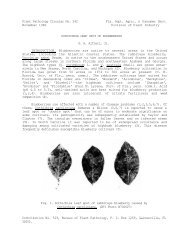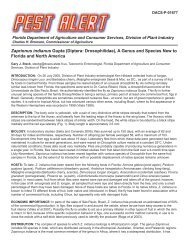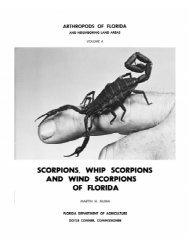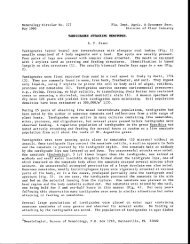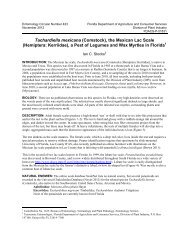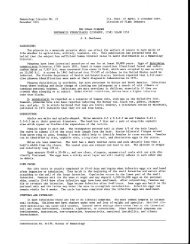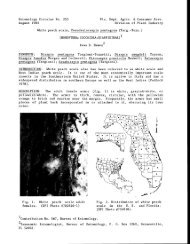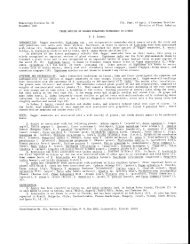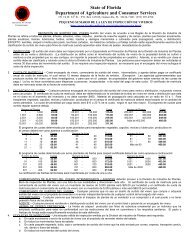A Checklist of the Beetles of Cuba with Data on Distributions and ...
A Checklist of the Beetles of Cuba with Data on Distributions and ...
A Checklist of the Beetles of Cuba with Data on Distributions and ...
Create successful ePaper yourself
Turn your PDF publications into a flip-book with our unique Google optimized e-Paper software.
REFERENCES<br />
Genaro, J.A. 1996. Resumen del c<strong>on</strong>ocimiento<br />
sobre las meloides de <str<strong>on</strong>g>Cuba</str<strong>on</strong>g> (Insecta: Coleoptera).<br />
Carib. J. Sci. 32: 382-386.<br />
Sel<strong>and</strong>er, R.B. <strong>and</strong> J.K. Bouseman. 1960. Meloid<br />
beetles (Coleoptera) <str<strong>on</strong>g>of</str<strong>on</strong>g> <str<strong>on</strong>g>the</str<strong>on</strong>g> West Indies. Proc.<br />
U.S. Nati<strong>on</strong>al Museum 111: 197-226.<br />
Sel<strong>and</strong>er, R.B. <strong>and</strong> J.K. Bouseman. 1961.<br />
Supplementary records <str<strong>on</strong>g>of</str<strong>on</strong>g> meloid beetles (Coleoptera)<br />
<str<strong>on</strong>g>of</str<strong>on</strong>g> <str<strong>on</strong>g>the</str<strong>on</strong>g> West Indies. Ent. News 73: 190-<br />
191.<br />
146. MYCTERIDAE<br />
The palm <strong>and</strong> flower beetles<br />
This family occurs in North America, Eurasia,<br />
<strong>and</strong> North Africa, <strong>and</strong> <str<strong>on</strong>g>the</str<strong>on</strong>g> tropics. These probably<br />
occur in <str<strong>on</strong>g>Cuba</str<strong>on</strong>g> in leaf axils <str<strong>on</strong>g>of</str<strong>on</strong>g> palms.<br />
SUBFAMILY LACCONOTINAE<br />
C<strong>on</strong>omorphus Champi<strong>on</strong> 1889: 98<br />
C. sp.<br />
Distributi<strong>on</strong>. <str<strong>on</strong>g>Cuba</str<strong>on</strong>g>. Endemic<br />
<str<strong>on</strong>g>Cuba</str<strong>on</strong>g> localities.<br />
Collecti<strong>on</strong>s.<br />
SUBFAMILY HEMIPEPLINAE<br />
Hemipeplus Berthold 1827: 384<br />
H. marginipennis (LeC<strong>on</strong>te) 1854: 79 (Nemicellus);<br />
Pollock 1999: 57<br />
[H. microphthalmus (Schwarz) 1878: 360<br />
(Nemicellus)]; as syn<strong>on</strong>ym (Blackwelder 1945:<br />
423); not in <str<strong>on</strong>g>Cuba</str<strong>on</strong>g><br />
Distributi<strong>on</strong>. <str<strong>on</strong>g>Cuba</str<strong>on</strong>g>, Bahamas, Mexico, USA<br />
(FL, GA)<br />
<str<strong>on</strong>g>Cuba</str<strong>on</strong>g> localities. Ci: Cayamas. Gu:<br />
Guantánamo<br />
Collecti<strong>on</strong>s. Gainesville. Washingt<strong>on</strong><br />
H. l<strong>on</strong>giscapus Pollock 1999: 61<br />
Distributi<strong>on</strong>. <str<strong>on</strong>g>Cuba</str<strong>on</strong>g>. Endemic<br />
<str<strong>on</strong>g>Cuba</str<strong>on</strong>g> localities. Ci: Cayamas (t.l.)<br />
Collecti<strong>on</strong>s. Washingt<strong>on</strong> (type)<br />
H. glabratus Pollock 1999: 61<br />
Distributi<strong>on</strong>. <str<strong>on</strong>g>Cuba</str<strong>on</strong>g>. Endemic<br />
<str<strong>on</strong>g>Cuba</str<strong>on</strong>g> localities. Ci: Cayamas (t.l.)<br />
Collecti<strong>on</strong>s. Gainesville. Pollock. Washingt<strong>on</strong><br />
(type)<br />
Holopeplus Arrow 1930: 230<br />
H. gundlachi (Grouvelle) 1878: XLIV (Hemipeplus);<br />
Pollock 1999: 56<br />
H. cubensis Arrow 1930: 230<br />
Distributi<strong>on</strong>. <str<strong>on</strong>g>Cuba</str<strong>on</strong>g>, Bahamas<br />
A <str<strong>on</strong>g>Checklist</str<strong>on</strong>g> <str<strong>on</strong>g>of</str<strong>on</strong>g> <str<strong>on</strong>g>the</str<strong>on</strong>g> <str<strong>on</strong>g>Beetles</str<strong>on</strong>g> <str<strong>on</strong>g>of</str<strong>on</strong>g> <str<strong>on</strong>g>Cuba</str<strong>on</strong>g> 161<br />
<str<strong>on</strong>g>Cuba</str<strong>on</strong>g> localities. Ci: Cayamas. Ho<br />
Collecti<strong>on</strong>s. L<strong>on</strong>d<strong>on</strong>. Paris (type, Grouvelle<br />
colln.). Washingt<strong>on</strong><br />
REFERENCES<br />
Pollock, D. A. 1999. Review <str<strong>on</strong>g>of</str<strong>on</strong>g> <str<strong>on</strong>g>the</str<strong>on</strong>g> New World<br />
Hemipeplinae (Coleoptera: Mycteridae) <str<strong>on</strong>g>with</str<strong>on</strong>g> descripti<strong>on</strong>s<br />
<str<strong>on</strong>g>of</str<strong>on</strong>g> ten new species. Ent. Sc<strong>and</strong>. 30:<br />
47-73.<br />
147. FAMILY BORIDAE<br />
This family occurs <strong>on</strong>ly in <str<strong>on</strong>g>the</str<strong>on</strong>g> Holarctic regi<strong>on</strong>.<br />
Larvae live under <str<strong>on</strong>g>the</str<strong>on</strong>g> bark <str<strong>on</strong>g>of</str<strong>on</strong>g> decaying c<strong>on</strong>ifers.<br />
148. FAMILY TRICTENOTOMIDAE<br />
This family occurs <strong>on</strong>ly in Asia <strong>and</strong> <str<strong>on</strong>g>the</str<strong>on</strong>g> East<br />
Indies. The larvae probably live in rotten wood.<br />
149. FAMILY PYTHIDAE<br />
This family occurs in North, Central, <strong>and</strong> South<br />
America, but is not known from <str<strong>on</strong>g>the</str<strong>on</strong>g> West Indies.<br />
The larvae feed under rotten bark.<br />
150. FAMILY PYROCHROIDAE<br />
The fire-colored beetles<br />
This family occurs in North America, <strong>and</strong> has<br />
a species apiece in French Guiana <strong>and</strong> Chile. It is<br />
apparently absent from México, Central America,<br />
<strong>and</strong> <str<strong>on</strong>g>the</str<strong>on</strong>g> West Indies. Adults are short-lived <strong>and</strong> may<br />
be collected at lights. The larvae occur under bark.<br />
151. FAMILY SALPINGIDAE<br />
The narrow-waisted bark beetles<br />
The larvae <str<strong>on</strong>g>of</str<strong>on</strong>g> most species occur under bark,<br />
in decaying wood, or leaf axils.<br />
SUBFAMILY DACODERINAE<br />
Dacoderus LeC<strong>on</strong>te 1858: 74<br />
D. dominicensis Horn 1874: 219<br />
Distributi<strong>on</strong>. <str<strong>on</strong>g>Cuba</str<strong>on</strong>g>, Hispaniola<br />
<str<strong>on</strong>g>Cuba</str<strong>on</strong>g> localities.<br />
Collecti<strong>on</strong>s.<br />
152. FAMILY ANTHICIDAE<br />
The ant-like flower beetles<br />
Reviewed by D. Ch<strong>and</strong>ler, March, 2001<br />
Adults occur <strong>on</strong> vegetati<strong>on</strong> <strong>and</strong> in leaf litter.<br />
They are predators or scavengers. Many species in<br />
this family were described by LaFerté-Sénectère<br />
<strong>and</strong> <str<strong>on</strong>g>the</str<strong>on</strong>g> correct publicati<strong>on</strong> dates are discussed in<br />
Ch<strong>and</strong>ler (1999).


